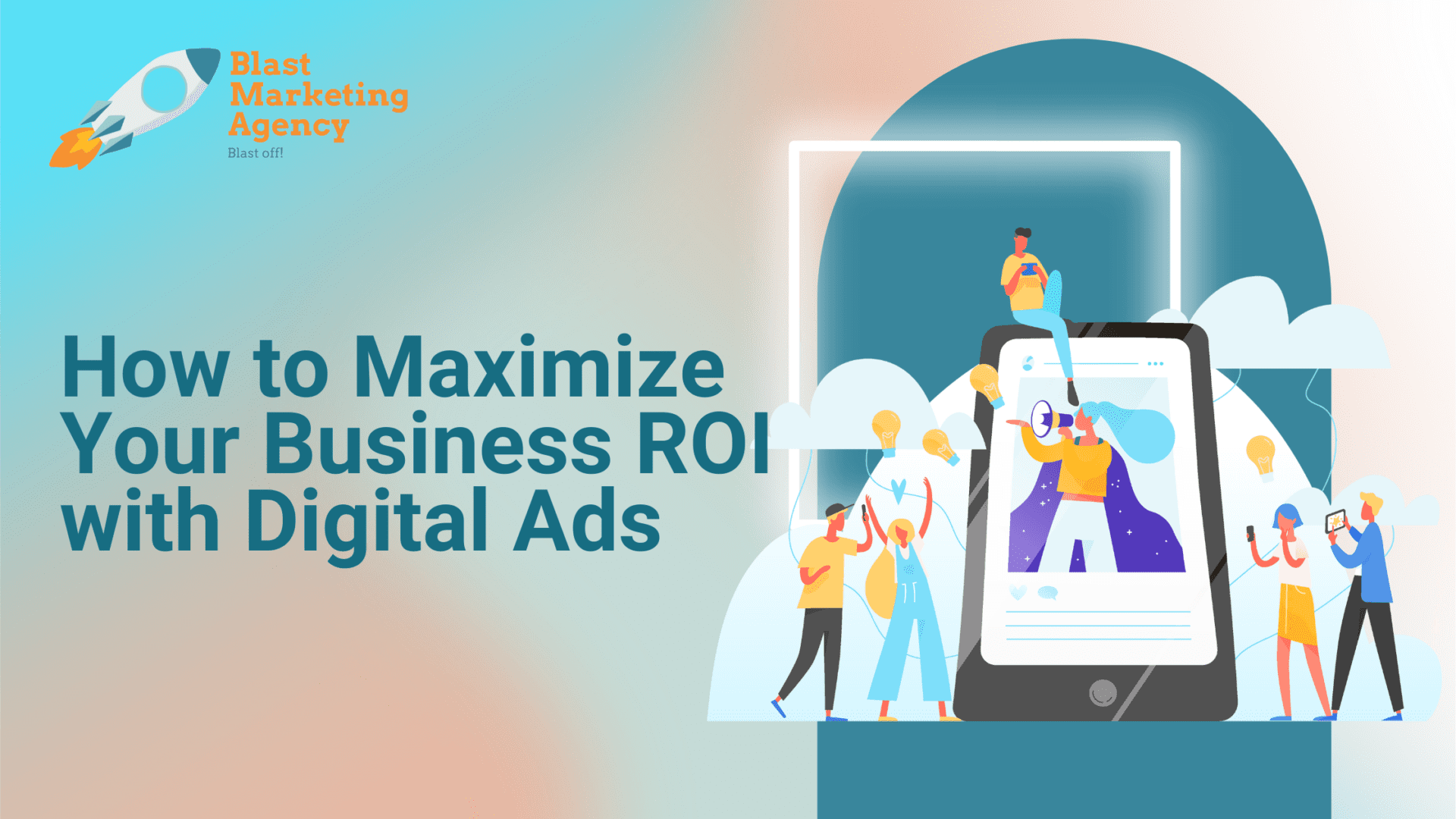
- Maximize returns by targeting the right audience, refining strategies, and choosing ad platforms based on business goals and budget.
- Craft compelling ad copy, use high-impact visuals, and leverage retargeting to engage users and boost conversions efficiently.
- Monitor key metrics, run A/B tests, and utilize AI tools to optimize ad spend, improve conversions, and drive sustainable growth.
Digital advertising has transformed how businesses connect with potential customers. Regardless of your business, the right ad strategy can turn clicks into revenue. But running ads without a clear plan can drain your budget quickly, leaving you with little to show for it. Maximizing return on investment (ROI) means spending wisely, targeting the right audience, and constantly refining your approach. The goal isn’t just to spend more, it’s to spend smarter.
Understanding ROI or ROAS (Return on Advertising Spend) in Digital Advertising
ROI or ROAS in digital advertising measures how much revenue your business generates for every dollar spent on ads. A high ROI means your campaigns are working efficiently, while a low ROI signals wasted ad spend or ineffective targeting.
For small businesses, every dollar counts. Unlike large corporations with massive marketing budgets, smaller companies need ads to drive real results. Yet many businesses struggle with tracking ROI properly. They focus on vanity metrics like impressions and clicks without considering conversions or customer lifetime value.
Let’s say a local medical practice runs a Google Ads campaign that brings in 1,000 website visitors. If only ten of those visitors book an appointment, and each appointment brings in $200, the total revenue generated is $2,000. If the practice spent $500 on ads, their ROI is ($2,000 − $500) / $500 = 300%. This simple calculation helps businesses understand whether their ad spend is paying off.
A common mistake is looking at ROI in isolation. Some campaigns drive immediate sales, while others build long-term brand awareness. Both have value, but understanding the difference helps businesses make smarter ad investments.
Choosing the Right Digital Advertising Channels
Not all ad platforms work the same way. The right choice depends on your business type, audience, and marketing goals.
Google Ads
Google Ads works well for businesses that rely on search-driven traffic. When someone types “best personal injury attorney near me” or “emergency plumber in NYC,” they’re actively looking for a service. These high-intent searches make Google Ads one of the fastest ways to drive leads.
Search ads operate on a pay-per-click model, meaning you only pay when someone clicks your ad. However, competition can be fierce, especially in industries like legal services or insurance. To avoid overspending, businesses should focus on specific keywords rather than broad, expensive terms.
Facebook & Instagram Ads
Social media platforms like Facebook and Instagram are powerful for brand awareness and retargeting. Unlike search ads, social media advertising reaches users based on interests, behaviors, and demographics.
Video and carousel ads perform especially well on social media. A short, engaging video can introduce your brand in seconds, while a carousel ad allows businesses to showcase multiple products or services in a single campaign.
YouTube & Video Advertising
YouTube ads are ideal for businesses that want to educate or entertain their audience. A law firm can use video ads to explain common legal issues, while an eCommerce brand can showcase products in action. Because YouTube ads run before or during videos people already watch, they have a high engagement rate when done well.
Display Ads & Programmatic Advertising
Display ads appear on websites across the internet, keeping your brand in front of potential customers. These ads remind people about your business after they visit your website but don’t convert.
Programmatic advertising takes display ads a step further by using AI to place ads where they’re most likely to convert. Instead of manually selecting websites, businesses let data-driven algorithms determine the best ad placements. This approach increases efficiency and reduces wasted ad spend.
Choosing the right mix of platforms depends on your industry, budget, and goals. Understanding each platform’s strengths helps businesses invest in the right places.
Creating High-Performing Ad Campaigns
Once you’ve selected the right platforms, the next step is crafting ads that capture attention and drive action. A well-structured campaign blends compelling visuals, persuasive copy, and strategic targeting to reach the right people at the right time.
Writing Ad Copy That Converts
The best ads connect with the audience’s needs. Instead of saying, “We offer professional accounting services,” a more effective approach would be, “Struggling with tax season? Let our accountants handle the numbers so you can focus on growing your business.” This small shift makes the message more relatable and action-driven.
Clarity matters just as much as creativity. Long-winded descriptions or industry jargon can lose potential customers. Instead, focus on concise, benefit-driven messaging. Social proof, such as testimonials or star ratings, can also increase credibility and encourage clicks.
Choosing the Right Visuals and Formats
People process images faster than text, so the right visuals can make or break an ad. For platforms like Facebook and Instagram, eye-catching graphics or short-form videos often perform better than plain text ads. Businesses should experiment with different ad formats, like carousel ads, slideshows, or GIFs, to see what captures the most engagement.
For service-based businesses, before-and-after photos, behind-the-scenes footage, or client success stories can add authenticity. A law firm could showcase a short client testimonial, while a fitness studio might feature a quick workout demo. The goal is to make ads feel natural rather than overly promotional.
Targeting and Retargeting for Better Results
Even the best ad won’t perform well if it’s shown to the wrong audience. Targeting allows businesses to narrow down who sees their ads based on location, age, interests, and online behavior. Google Ads uses keyword targeting, while Facebook and Instagram allow businesses to create audience segments based on past engagement, demographics, and purchasing habits.
Retargeting takes this a step further by re-engaging people who have already interacted with a business. If someone visits an online store but doesn’t complete a purchase, retargeting ads can remind them about the product they viewed. This strategy helps businesses capture leads that might have otherwise been lost.
Budgeting and Bidding Strategies
Spending more money on ads doesn’t always translate to better results. A well-planned budget and bidding strategy help businesses get the most out of their advertising dollars.
Setting a Realistic Budget
Budgeting for digital ads depends on business goals, industry competition, and expected returns. A local business with a niche audience may need a smaller budget than a national eCommerce brand competing with major retailers. Instead of guessing, businesses can use cost-per-click (CPC) and cost-per-acquisition (CPA) estimates to determine how much they should allocate.
If an insurance provider knows their average customer brings in $500 in revenue and their conversion rate is 5%, they can calculate how much they can afford to spend per lead. A business spending $1,000 per month should track whether that investment is leading to profitable customer conversions.
Understanding Bidding Models
Most ad platforms use an auction system where businesses bid against competitors for ad placements. Google Ads offers bidding strategies like:
- Cost-Per-Click (CPC): Paying only when someone clicks the ad.
- Cost-Per-Thousand Impressions (CPM): Paying based on the number of people who see the ad, whether they click or not.
- Cost-Per-Action (CPA): Paying only when a specific action, like a purchase or sign-up, is completed.
Choosing the right bidding model depends on campaign goals. A law firm looking to generate leads may benefit from CPA bidding, while a brand focused on awareness may prefer CPM bidding to maximize reach.
Adjusting Campaigns for Maximum Efficiency
Ads shouldn’t run on autopilot. Regularly analyzing performance data helps businesses fine tune their campaigns. If a Google Ads campaign has a high CPC but low conversions, adjusting keywords or ad copy may improve results. If a Facebook ad gets a lot of impressions but few clicks, testing different images or headlines can help.
Tracking return on ad spend (ROAS) over time allows businesses to shift budgets toward the most profitable campaigns. Scaling successful ads and pausing underperforming ones prevents unnecessary spending.
Tracking and Measuring Ad Performance

To maximize ROI, businesses need to know which ads are working and which aren’t. Data-driven decisions prevent wasted budgets and help refine future campaigns.
Key Performance Metrics to Watch
Each ad platform provides detailed analytics, but not every metric carries the same weight. The most important ones include:
- Click-Through Rate (CTR): The percentage of people who click on the ad after seeing it. A low CTR may indicate weak messaging or poor audience targeting.
- Conversion Rate: The percentage of users who take a desired action, such as filling out a contact form or making a purchase.
- Return on Ad Spend (ROAS): The amount of revenue generated for every dollar spent on ads.
- Cost Per Lead (CPL): The average cost of acquiring a new lead through the campaign.
By tracking these numbers, businesses can determine whether their campaigns are profitable or need adjustments.
Using A/B Testing to Improve Performance
A/B testing (or split testing) compares two versions of an ad to see which performs better. This method allows businesses to test different headlines, images, call-to-action buttons, or audience segments.
A restaurant running Facebook ads might test two versions of a promo: one highlighting a discount and another showcasing customer reviews. The ad with the higher conversion rate can then be scaled for better results.
Leveraging AI and Automation for Smarter Decisions
AI-powered ad tools can automatically adjust bids, optimize audience targeting, and even generate ad variations based on performance data. Google’s Smart Bidding and Facebook’s Advantage+ campaigns use machine learning to optimize ad delivery. Businesses that embrace these tools gain an advantage by letting data-driven algorithms improve campaign efficiency.
Regular performance reviews, testing new approaches, and leveraging automation keep ad campaigns running at their best. By continuously refining strategies, businesses can achieve stronger results without increasing their ad spend.
Common Pitfalls to Avoid in Digital Advertising
Even the most well-planned ad campaigns can run into issues that drain budgets and limit returns. Many businesses struggle with the same mistakes, often leading to poor engagement and missed opportunities.
Focusing on Clicks Instead of Conversions
A high click-through rate (CTR) might look impressive, but clicks alone don’t generate revenue. Many businesses fall into the trap of optimizing ads solely for engagement rather than conversions. If an ad is driving traffic but few users take action, the campaign needs adjustment.
Overlooking Audience Segmentation
Casting a wide net might seem like a way to reach more customers, but in digital advertising, specificity wins. Running the same ad for every user, regardless of demographics, behavior, or interests, can result in lower engagement and higher costs.
Neglecting Mobile Optimization
With most users browsing and shopping on their phones, ads that aren’t optimized for mobile can lose potential customers. Slow-loading landing pages, text-heavy ads, or visuals that don’t scale properly on smaller screens create a frustrating experience.
Ignoring Ad Fatigue
Even a strong-performing ad can lose effectiveness over time. When people see the same ad repeatedly, they start tuning it out or even feeling annoyed by it. This leads to lower engagement and higher costs per result.
Setting It and Forgetting It
Digital ads need ongoing adjustments, yet some businesses take a “set it and forget it” approach. Without regular monitoring, underperforming ads can drain the budget, while high-performing ones may not be scaled effectively.
Regular performance checks, testing new variations, and reallocating budgets based on results keep campaigns running efficiently. Digital advertising isn’t static, and businesses that stay engaged with their data make smarter decisions.
If you’re ready to maximize your ROI or ROAS with data-driven digital ads, our team at Blast Marketing Agency is here to help. We craft strategic campaigns that drive real results for your business. Schedule a call with us today!
Blast Marketing – The Agency for Small Companies With Big Dreams!
